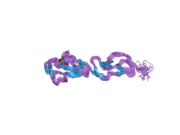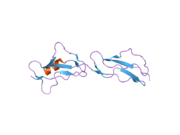CFHR1
Protein-coding gene in the species Homo sapiens
| CFHR1 | |||||||||||||||||||||||||||||||||||||||||||||||||||
|---|---|---|---|---|---|---|---|---|---|---|---|---|---|---|---|---|---|---|---|---|---|---|---|---|---|---|---|---|---|---|---|---|---|---|---|---|---|---|---|---|---|---|---|---|---|---|---|---|---|---|---|
 | |||||||||||||||||||||||||||||||||||||||||||||||||||
| |||||||||||||||||||||||||||||||||||||||||||||||||||
| Identifiers | |||||||||||||||||||||||||||||||||||||||||||||||||||
| Aliases | CFHR1, CFHL, CFHL1, CFHL1P, CFHR1P, FHR1, H36-1, H36-2, HFL1, HFL2, complement factor H related 1 | ||||||||||||||||||||||||||||||||||||||||||||||||||
| External IDs | OMIM: 134371; MGI: 2138169; HomoloGene: 55632; GeneCards: CFHR1; OMA:CFHR1 - orthologs | ||||||||||||||||||||||||||||||||||||||||||||||||||
| |||||||||||||||||||||||||||||||||||||||||||||||||||
| |||||||||||||||||||||||||||||||||||||||||||||||||||
| |||||||||||||||||||||||||||||||||||||||||||||||||||
| |||||||||||||||||||||||||||||||||||||||||||||||||||
| |||||||||||||||||||||||||||||||||||||||||||||||||||
| Wikidata | |||||||||||||||||||||||||||||||||||||||||||||||||||
| |||||||||||||||||||||||||||||||||||||||||||||||||||
Complement factor H-related protein 1 is a protein that in humans is encoded by the CFHR1 gene.[5][6][7]
References
- ^ a b c GRCh38: Ensembl release 89: ENSG00000244414 – Ensembl, May 2017
- ^ a b c GRCm38: Ensembl release 89: ENSMUSG00000057037 – Ensembl, May 2017
- ^ "Human PubMed Reference:". National Center for Biotechnology Information, U.S. National Library of Medicine.
- ^ "Mouse PubMed Reference:". National Center for Biotechnology Information, U.S. National Library of Medicine.
- ^ Skerka C, Horstmann RD, Zipfel PF (Jul 1991). "Molecular cloning of a human serum protein structurally related to complement factor H". J Biol Chem. 266 (18): 12015–20. doi:10.1016/S0021-9258(18)99058-7. PMID 1711047.
- ^ Estaller C, Koistinen V, Schwaeble W, Dierich MP, Weiss EH (May 1991). "Cloning of the 1.4-kb mRNA species of human complement factor H reveals a novel member of the short consensus repeat family related to the carboxy terminal of the classical 150-kDa molecule" (PDF). J Immunol. 146 (9): 3190–6. doi:10.4049/jimmunol.146.9.3190. PMID 1826708.
- ^ "Entrez Gene: CFHR1 complement factor H-related 1".
Further reading
- Zipfel PF, Skerka C (1994). "Complement factor H and related proteins: an expanding family of complement-regulatory proteins?". Immunol. Today. 15 (3): 121–6. doi:10.1016/0167-5699(94)90155-4. PMID 8172644.
- Zipfel PF, Jokiranta TS, Hellwage J, et al. (1999). "The factor H protein family". Immunopharmacology. 42 (1–3): 53–60. doi:10.1016/S0162-3109(99)00015-6. PMID 10408366.
- Timmann C, Leippe M, Horstmann RD (1991). "Two major serum components antigenically related to complement factor H are different glycosylation forms of a single protein with no factor H-like complement regulatory functions". J. Immunol. 146 (4): 1265–70. doi:10.4049/jimmunol.146.4.1265. PMID 1825108. S2CID 37805964.
- Park CT, Wright SD (1996). "Plasma lipopolysaccharide-binding protein is found associated with a particle containing apolipoprotein A-I, phospholipid, and factor H-related proteins". J. Biol. Chem. 271 (30): 18054–60. doi:10.1074/jbc.271.30.18054. PMID 8663389.
- Díaz-Guillén MA, Rodríguez de Córdoba S, Heine-Suñer D (1999). "A radiation hybrid map of complement factor H and factor H-related genes". Immunogenetics. 49 (6): 549–52. doi:10.1007/s002510050534. PMID 10380701. S2CID 31776506.
- Male DA, Ormsby RJ, Ranganathan S, et al. (2000). "Complement factor H: sequence analysis of 221 kb of human genomic DNA containing the entire fH, fHR-1 and fHR-3 genes". Mol. Immunol. 37 (1–2): 41–52. doi:10.1016/S0161-5890(00)00024-9. PMID 10781834.
- Strausberg RL, Feingold EA, Grouse LH, et al. (2003). "Generation and initial analysis of more than 15,000 full-length human and mouse cDNA sequences". Proc. Natl. Acad. Sci. U.S.A. 99 (26): 16899–903. Bibcode:2002PNAS...9916899M. doi:10.1073/pnas.242603899. PMC 139241. PMID 12477932.
- Gerhard DS, Wagner L, Feingold EA, et al. (2004). "The status, quality, and expansion of the NIH full-length cDNA project: the Mammalian Gene Collection (MGC)". Genome Res. 14 (10B): 2121–7. doi:10.1101/gr.2596504. PMC 528928. PMID 15489334.
- Pérez-Caballero D, García-Laorden I, Cortés G, et al. (2005). "Interaction between complement regulators and Streptococcus pyogenes: binding of C4b-binding protein and factor H/factor H-like protein 1 to M18 strains involves two different cell surface molecules". J. Immunol. 173 (11): 6899–904. doi:10.4049/jimmunol.173.11.6899. PMID 15557185.
- Rual JF, Venkatesan K, Hao T, et al. (2005). "Towards a proteome-scale map of the human protein-protein interaction network". Nature. 437 (7062): 1173–8. Bibcode:2005Natur.437.1173R. doi:10.1038/nature04209. PMID 16189514. S2CID 4427026.
- McDowell JV, Lankford J, Stamm L, et al. (2005). "Demonstration of factor H-like protein 1 binding to Treponema denticola, a pathogen associated with periodontal disease in humans". Infect. Immun. 73 (11): 7126–32. doi:10.1128/IAI.73.11.7126-7132.2005. PMC 1273895. PMID 16239506.
- Liu T, Qian WJ, Gritsenko MA, et al. (2006). "Human plasma N-glycoproteome analysis by immunoaffinity subtraction, hydrazide chemistry, and mass spectrometry". J. Proteome Res. 4 (6): 2070–80. doi:10.1021/pr0502065. PMC 1850943. PMID 16335952.
- Gregory SG, Barlow KF, McLay KE, et al. (2006). "The DNA sequence and biological annotation of human chromosome 1". Nature. 441 (7091): 315–21. Bibcode:2006Natur.441..315G. doi:10.1038/nature04727. PMID 16710414.
- Zipfel PF, Edey M, Heinen S, et al. (2007). "Deletion of complement factor H-related genes CFHR1 and CFHR3 is associated with atypical hemolytic uremic syndrome". PLOS Genet. 3 (3): e41. doi:10.1371/journal.pgen.0030041. PMC 1828695. PMID 17367211.
- Haupt K, Kraiczy P, Wallich R, et al. (2007). "Binding of human factor H-related protein 1 to serum-resistant Borrelia burgdorferi is mediated by borrelial complement regulator-acquiring surface proteins". J. Infect. Dis. 196 (1): 124–33. doi:10.1086/518509. PMID 17538892.
- v
- t
- e
PDB gallery
-
 2bzm: SOLUTION STRUCTURE OF THE PRIMARY HOST RECOGNITION REGION OF COMPLEMENT FACTOR H
2bzm: SOLUTION STRUCTURE OF THE PRIMARY HOST RECOGNITION REGION OF COMPLEMENT FACTOR H -
 2g7i: Structure of Human Complement Factor H Carboxyl Terminal Domains 19-20: a Basis for Atypical Hemolytic Uremic Syndrome
2g7i: Structure of Human Complement Factor H Carboxyl Terminal Domains 19-20: a Basis for Atypical Hemolytic Uremic Syndrome
External links
- Human CFHR1 genome location and CFHR1 gene details page in the UCSC Genome Browser.
- GeneReviews/NCBI/NIH/UW entry on Atypical Hemolytic-Uremic Syndrome
- OMIM entries on Atypical Hemolytic-Uremic Syndrome
 | This article on a gene on human chromosome 1 is a stub. You can help Wikipedia by expanding it. |
- v
- t
- e


















